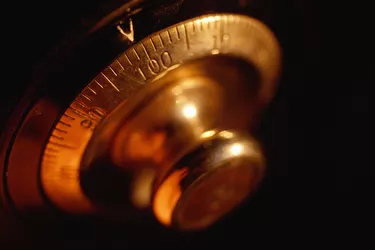
Most safes and locks utilize combination codes to lock and unlock them rather than keys. This has long been regarded as a more secure method of locking because, while a key can be stolen, a combination code isn't a physical object that can be taken. Also, it is typically harder to pick a combination lock than a standard key lock, making it more difficult to break into safes with combination locks.
Identifying
Video of the Day
There are two types of combination safes available: those that use a dial combination lock and those that use an electronic combination lock. Electronic locks require batteries or an alternate power source to operate, and typically work by entering a 4-digit combination into a telephone-style keypad. Dial combination locks operate without electricity and usually have a 3-digit code. The combination is entered by turning a dial, which is marked with notches and numbers to show the operator what point on the dial to stop. The dial typically has 60 numbered notches, although commercial safes may have more. The dial is the single most obvious feature when identifying whether a safe uses a dial combination lock or an electronic combination lock.
Video of the Day
Opening
Start by resetting the lock so that the mechanical elements know you are beginning a new combination rather than continuing from the number that was last entered. Rotate the dial in a clockwise motion for three complete rotations to reset the lock. Keep turning the dial clockwise until you reach the first number in the combination, then stop. Turn the dial counterclockwise a full rotation, and continue until you reach the second number in the combination. Stop on the second number and then begin turning the dial clockwise once more until you reach the final number in the combination. Stop on the final number and lift the lever on the front of the safe to open the lock.
To lock the safe back, simply close the door, lower the lever and turn the dial on the combination lock. Changing the number on the lock is very important. If the dial is left to rest on the final number in the combination, the lock will remain unlocked and anyone can open the safe.
Hiding the Safe
Hiding the safe is an important aspect of securing the valuables inside. This is particularly true in the case of smaller, lightweight safes that could be carried away. Have a professional install your safe into a wall, where it can be covered by a picture, tapestry or furniture. Keeping the safe inside a locked cabinet or desk drawer is also a viable option. In the event that a safe is large enough that it is difficult to hide, consider purchasing some extra weights to keep in the bottom of the safe, making it less likely to be stolen.